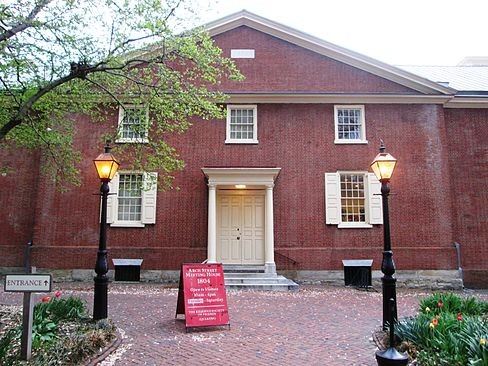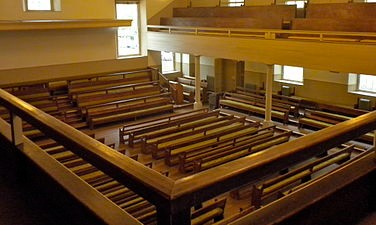Arch Street Friends Meeting House (Box Brown's Shipping Destination)
Introduction
Text-to-speech Audio
The Quaker meeting house was built between 1803 and 1805. The simplicity and classic beauty of the building reflect the Society of Friends (also known as the Quakers) and their values of thrift, humility, charitable work, and the rejection of materialism. The meeting house is open for tours and is still used as a center for worship.
It hosts the Philadelphia Yearly Meetings of Friends, a general conference that also serves as the central organizing body for the Quakers. The meetinghouse was built upon a Quaker burial ground. One of the earliest symbols of the Quaker belief in equality, the Society of Friends allowed non-members, Native Americans, and African Americans to be buried here.
The building was also the final stop for many on the Underground Railroad, after a hard journey north they could find friends and support from the Quaker community in Philadelphia. Famous escaped slave, public speaker, and magician, Henry "Box" Brown was unboxed here in front of an audience of abolitionists on March 30th, 1849.
Images
The Arch Street Meeting House is a National Historic Landmark and still in use. Photo by Beyond My Ken on Wikimedia Commons (CC BY-SA 4.0)

The historic West Room which is still furnished as it was in 1811. Photo by Smallbones on Wikimedia Commons (public domain).

Backstory and Context
Text-to-speech Audio
In the annals of Philadelphia's history, few buildings stand as resolute monuments to the passage of time and the enduring spirit of community quite like the Flemish bond brick edifice that graces the city's landscape. Its origins can be traced back to the early nineteenth century, a period marked by the burgeoning growth of a young nation and the steadfast commitment of its citizens to forge a path of religious freedom and social progress.
The narrative of this architectural marvel begins with a gesture of generosity from none other than William Penn himself, who, in the twilight years of the 1600s, bestowed upon the Friends community a parcel of land destined to become a sacred burial ground. Little did he know then that his benevolent act would sow the seeds for a place of worship that would echo with the prayers and aspirations of generations to come. In the absence of a dedicated structure, faithful adherents gathered in the intimate confines of private homes to commune with one another and seek solace in their shared beliefs.
It wasn't until the dawn of the nineteenth century that the vision of a permanent sanctuary began to take shape. Between the years of 1803 and 1805, with meticulous attention to detail and a reverence for tradition, the cornerstone of the present-day meeting house was laid. Guided by the deft hand of an architect believed to be Owen Biddle, the structure emerged from the earth, its Flemish bond brickwork a testament to the craftsmanship of generations past. By 1811, an additional wing had been seamlessly integrated into the original design, a testament to the community's commitment to growth and inclusivity.
Stepping across the threshold of this venerable institution, visitors are transported back in time, enveloped by an aura of reverence and tranquility that permeates every corner of its hallowed halls. The echoes of centuries past reverberate through the air as one traverses the simple yet elegant meeting house, where time seems to stand still amidst the whispers of bygone conversations and the solemnity of shared reflection.
The architectural integrity of the building remains remarkably intact, a testament to the enduring craftsmanship of its creators. Original features such as the sturdy walls, lofty ceiling, and polished wooden floors serve as silent witnesses to the passage of time, while the meticulously preserved windows bathe the interior in a soft, ethereal light. Among its many treasures, the meeting house boasts a remarkable collection of crown glass windowpanes, a testament to the ingenuity and artistry of generations past.
In 1854, as the nation stood on the precipice of great change, two cupolas were added to the structure, not merely as decorative embellishments, but as vital conduits for ventilation, ensuring the comfort and well-being of those who gathered within its walls. It was a subtle yet significant modification, a nod to the ever-evolving needs of a growing community.
But the significance of this meeting house extends far beyond its architectural splendor. It serves as a living testament to the pivotal role played by the Quaker community in the abolitionist movement—a beacon of hope and sanctuary for those who dared to dream of a more just and equitable society. Within its walls, anti-slavery pamphlets were printed and distributed, while fervent discussions and impassioned speeches echoed through its halls.
It was here, amidst the hushed whispers of clandestine meetings and the fervent prayers of the faithful, that Henry 'Box' Brown, following his daring escape from slavery, found refuge and solidarity among kindred spirits. It is said that after his harrowing journey to freedom, Brown sought shelter in the nearby Mott residence, where he was welcomed with open arms by local abolitionists who frequented the meeting house. In the years that followed, he may have returned to these sacred grounds, his presence a reminder of the indomitable spirit of those who dared to defy the shackles of oppression.
Recognized for its historical significance, the meeting house was duly honored with a place on the National Register of Historic Places in 1971, a testament to its enduring legacy and cultural importance. In 1988, it was further distinguished as a National Historic Landmark, a fitting tribute to its role in shaping the fabric of American history.
Today, centuries removed from its humble beginnings, the meeting house continues to serve as a beacon of hope and inspiration for all who pass through its doors. It remains a cherished site for worship services, a gathering place for the faithful, and a testament to the enduring values of community, compassion, and social justice. As the custodians of this venerable institution, we are tasked with preserving its legacy for future generations, ensuring that the echoes of the past continue to resonate within its hallowed halls for centuries to come.
Sources
Pennsylvania Register of Historic Sites and Landmarks. Arch Street Friends Meeting House, National Register of Historic Places Inventory -- Nomination Form, National Archives. January 11, 1971. Accessed March 18th 2021. https://catalog.archives.gov/id/71997016.
William Still, The Underground Railroad (Philadelphia: Porter & Coates, 1872).
https://commons.wikimedia.org/wiki/File:Arch_Street_Meetinghouse_from_front.jpg
https://commons.wikimedia.org/wiki/File:Arch_St_Meeting_interior.JPG
